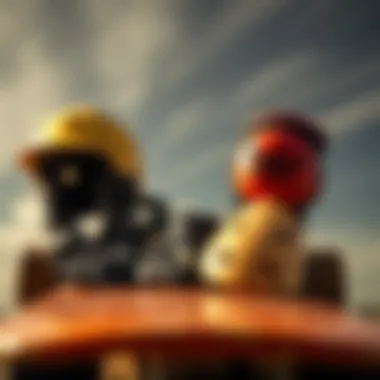Mastering Longboarding Techniques and Safety Tips


Intro
Longboarding isn't just about gliding down a hill; it’s about mastering balance, control, and the subtle art of navigating different terrains. Whether you're an eager beginner or someone who’s been rolling for a while, this guide seeks to expand your horizon and refine your skills. Longboarding encompasses a variety of techniques and styles, each contributing to the overall experience of the sport. From selecting the right equipment to honing your technique, every facet plays a critical role in your development as a longboarder.
Let’s take a deep dive into the nuances of longboarding—transforming you from a novice into a confident rider who understands the nuances of balance, turning, and safety.
Surfing Techniques
The term "surfing techniques" might sound more at home in a beachside conversation, but in longboarding, it signifies the skillful maneuvers you can perform on your board. Mastering these techniques is key to enjoying the ride to its fullest.
Beginner Tips for Getting Started
Beginning your longboarding journey might seem daunting, but with proper techniques, you can feel at ease on your board.
- Find Your Stance: Before you kick off, figure out whether you’re regular (left foot forward) or goofy (right foot forward). A simple way to test this is to see which foot you naturally use to push off.
- Practice Balance: Start on a flat surface. Shift your weight from your toes to your heels to understand the board’s response. The more comfortable you are balancing, the more confidence you'll build.
- Learn How to Push: Place your back foot on the tail of the board while using your front foot to steer. Push off gently with your back foot, aiming for gradual acceleration instead of a powerful kick.
- Stop Safely: Learning to stop is crucial! Use foot braking by pressing down with your back foot or practicing a heel drag by slowly dragging your foot along the ground.
Advanced Maneuvers and Tricks
Once you’ve nailed the basics, it’s time to level up your skills. Here are some advanced techniques that can really elevate your longboarding game:
- Carving: Adjust your weight on the board while turning to carve smoothly through corners. Keep your knees slightly bent for more control.
- Sliding: This technique helps you maintain speed and change direction without losing momentum. Start with gentle slides and progress to more advanced sliding techniques, like the Coleman slide.
- Tight Turns: When you're comfortable, practice initiating tight turns using your shoulders, hips, and feet together to create smooth direction changes.
Practice is the foundation of improvement; don't rush the learning process, and enjoy each ride.
Board Selection
Choosing the right longboard plays a significant role in your skill development and overall enjoyment. With so many options, it's easy to feel overwhelmed.
Choosing the Right Board for Your Style
Longboards come in various shapes and sizes. Here��’s what to consider when picking one:
- Deck Shape: For cruising, a wider deck like a pintail provides stability, while a drop-through deck lower the center of gravity, making it easier to push and brake.
- Length and Width: Longer boards are usually more stable, which is great for beginners, while shorter boards are better for tricks and maneuverability.
- Wheels: Softer wheels (78A-83A) offer better grip and absorb bumps, making them ideal for downhill rides. Harder wheels (83A-101A) slide easier, good for tricks.
Board Maintenance and Care
Proper care of your longboard can extend its lifespan and enhance your riding experience. Here are some simple maintenance tips:
- Clean the Wheels: Dust and debris can slow you down. Wipe the wheels and bearings regularly.
- Inspect the Trucks: Check for any looseness or wear and be sure to tighten any loose bolts.
- Store Properly: Avoid leaving your board in direct sunlight for long periods; this can warp the deck and damage the wheels.
The End
The road to mastering longboarding is both rewarding and challenging. It requires a blend of practice, the right equipment, and a commitment to safety. Whether you're carving streets, cruising beaches, or attempting tricks in a skate park, the diversity of longboarding enriches the experience of riders everywhere. The more you ride, the more you’ll learn about your style and preferences, allowing you to fully embrace this dynamic sport.
Prologue to Longboarding
Longboarding, while often seen as a leisurely pastime, captures a unique blend of skill, balance, and thrill. Understanding this sport isn’t just about strapping on a board; it’s about immersing oneself in an experience that offers both exhilaration and artistry in motion. This section will dive into why longboarding matters, the benefits it provides, and what newcomers should grasp about it before they embark on their ride.
Whether you're cruising down a smooth street on a sunny day or deftly navigating a winding hill, the appeal of longboarding lies in the versatility it offers. Unlike traditional skateboards, which are typically aimed at tricks and stunts, longboards facilitate distance gliding and carving, allowing riders to appreciate the landscapes they traverse. Beyond mere transportation, longboarding helps improve balance and coordination, serving as an excellent full-body workout as you engage your core and legs with every push.
Key Benefits of Longboarding:
- Physical Fitness: Positions you to strengthen leg muscles and enhance cardiovascular health.
- Mental Clarity: The focused nature of balancing and navigating can serve as a form of meditation, clearing your mind and heightening your awareness of your surroundings.
- Community Engagement: With its growing popularity, connecting with other longboarders opens doors to friendships and camaraderie.
As you embark on your journey into the world of longboarding, it’s crucial to grasp the basics of its development and how it stands apart from its sibling, skateboarding. First, we must appreciate the flexible nature of this wheel-driven pastime, its evolution over the years, and what draws thousands of enthusiasts into its fold.
The Evolution of Longboarding
From its origins in the coastal streets of California, longboarding has morphed into a diverse form of skating that continues to grow each year. Initially birthed as a way for surfers to practice their turns on dry land, longboarding has evolved into a distinct sport with its styles and cultures. Various longboard designs have emerged, catering to specific riding styles, making it more accessible to people of all ages and abilities.
In the early days, longboards were simple planks with wheels, often constructed from wood. Today, the range of materials has expanded to include bamboo, fiberglass, and even carbon fiber. Longboards are broadly categorized in styles like cruising, downhill, and freestyle, each with its unique characteristics. Over the decades, technological advances and creativity have propelled longboarding into an art form.
Longboarding Compared to Skateboarding
At first glance, longboarding and skateboarding might seem like two peas in a pod, but they differ significantly in several aspects. Longboards are generally longer and provide more surface area, which contributes to a smoother ride. While skateboards are shorter, designed for tricks and quick movements, longboards prioritize stability and ease.
Some key differences include:
- Stability: Longboards, with their larger wheelbase, tend to offer a more stable base, making them ideal for beginners who are still mastering balance.
- Speed: The design of longboards allows for greater momentum on downhill stretches, making them a favorite for thrill-seekers.
- Community Differences: The culture surrounding longboarding often emphasizes relaxation and cruising, while skateboarding is often associated with park tricks and competitions.
In summary, longboarding isn’t just about riding a board; it’s an immersive journey that combines adventure, community, and innovation. As you peel back the layers of this sport, you gain insights into its rich history and its endless possibilities, setting the stage for deeper exploration into techniques, gear, and safety practices that will enhance your riding experience.
Essential Gear for Longboarding
When you’re about to hit the pavement on your longboard, having the right gear is paramount. The right equipment not only enhances your riding experience but also plays a significant role in ensuring your safety. Longboarding can be thrilling, but it can also be risky without appropriate gear. This section dives into the essentials that every longboarder should consider, helping you make informed decisions.
Selecting the Right Longboard
Choosing a longboard is not just about picking a flashy design; it’s about understanding how different elements of the board can affect your ride. Here we’ll break down a couple of pivotal components in selecting the right board for you.
Types of Longboards
Longboards come in various shapes and sizes, each designed for specific styles of riding. For instance, the common varieties include cruiser boards, downhill boards, and freestyle boards. Cruisers are known for their stability and are ideal for leisurely rides, while downhill boards are crafted for speed, designed to handle sharper turns and steep declines. Freestyle boards are more versatile, allowing riders to perform tricks and flips.
For beginners, cruisers are often a favored choice due to their forgiving nature. They tend to have softer wheels, providing a smoother ride over cracks and bumps. However, they might not be the best choice if you are looking to push your limits and hit higher speeds. A downhill board is beneficial if you're interested in racing or downhill rides but remember they can be less forgiving for those just starting out.
Board Specifications
Board specifications range from length and width to the type of material used. Most boards are between 28 to 48 inches in length. Longer boards provide better stability, making them suitable for downhill riding, while shorter boards allow for greater maneuverability and are favored for tricks or commuting.
Material is also a key element; bamboo boards for instance are lightweight and flexible, which can offer a smooth ride. On the flip side, boards made from maple are more rigid and durable, catering to riders looking for a robust option.
Nevertheless, highly durable materials often mean heavier boards, which might not be the desired choice for all longboarders. Some riders might prefer a lighter board for ease of transportation around town.
Safety Equipment
No amount of thrill is worth a mishap. Hence, investing in proper safety gear should be a top priority. This equipment ranges from helmets to pads—each serving its purpose in protecting different facets of your body.
Helmets and Pads


Helmets are the first line of defense against head injuries and are often required by law in many regions. A good helmet should fit snugly without being overly tight. Some prefer full-face helmets for maximum protection, especially when riding at faster speeds downhill. Besides helmets, protective pads for wrists, knees, and elbows play a vital role in cushioning impact during falls. They can prevent scrapes and more severe injuries, especially if you're just starting or trying new tricks.
While some riders feel that pads may restrict movement, the benefits of protection can't be understated, especially for new riders still finding their balance.
Footwear Considerations
Footwear is an often-overlooked aspect of longboarding gear but is pivotal to your riding comfort and stability. A proper pair of shoes can provide grip, allowing for better control over your board. Skate shoes with a flat sole and sturdy grip are popular among longboarders for their efficiency.
However, some riders prefer shoes designed specifically for longboarding, which could have additional features for comfort and support. It’s vital to avoid shoes that are too bulky or have excessive cushioning as they may cause a lack of control over your foot placements, making it harder to push or carve.
“Safety doesn't happen by accident.”
Fundamental Techniques
Mastering fundamental techniques is critical in longboarding as these skills lay the groundwork for a rider's confidence and safety on the board. Like any sport, understanding the basics can drastically enhance your abilities, giving you the tools needed to tackle more advanced maneuvers. Let's break down the essential components that every longboarder should become adept at.
Balancing on the Board
Stance and Posture
When you're on the board, how you position yourself can make all the difference. An ideal stance involves having your feet shoulder-width apart with one foot towards the front, while the other remains close to the tail. This setup gives you a stable base, ideal for absorbing bumps and turning. If you stand like a penguin, you're in for a rough ride!
It's essential to keep your knees slightly bent and your back straight. A proper posture not only enhances control but also reduces the risk of falls. A well-structured stance encourages better weight transfer when maneuvering, helping you glide smoothly rather than wobbling like a jellyfish. Just remember, if you're feeling stiff, take a breather and re-adjust your stance—you'll find flexibility improves your ride immensely.
Weight Distribution
Weight distribution is another cornerstone of effective longboarding. The trick here is understanding where to place your weight during different actions. For instance, leaning back helps slow you down and provides stability, while shifting your weight forward lends speed and control as you push off.
A crucial aspect of weight distribution is knowing how to lean into your turns. If you're carving left, for example, lean left at the hips and shift some of your weight there. This allows the board to turn effortlessly. Not grasping this can leave you fighting for balance on turns, which certainly isn’t a picnic. Just as important as applying weight is removing it; if you lean too hard, you risk losing control.
Pushing and Propelling
Foot Positioning
Foot positioning plays a key role in how you get moving on your longboard. Your back foot should rest on the tail, while the front foot stays closer to the middle or slightly ahead. This placement generates power as you push off. The back foot serves as a lever, allowing you to push against the board effectively.
What you might not realize is that the angle of your feet matters too. A turned-out position can sometimes lead to instability, while a parallel alignment often provides a solid push. Experimenting with different positions will help you find what feels best. Sometimes, it's the yawning gaps in technique that make riders feel awkward while pushing—become aware of your own habits, and tweak them!
Momentum Maintenance
Keeping your momentum is vital for an enjoyable ride. Once you’re pushing, a good longboarder knows how to transition smoothly into coasting. Pumping your legs lightly, bending your knees, and using a bit of body weight can actually keep your speed up instead of hunching over like a turtle!
Understanding the rhythm of your movements helps in retaining momentum. Moreover, practicing this will allow you to develop a feel for your board. But beware—pushing too hard can deplete your own energy quickly. So, it's essential to find a balance between efficient pushing and conserving energy. Just because you can push hard doesn’t mean you always should.
Turning Techniques
Carving vs. Sliding
Carving is perhaps the more graceful of the two techniques you're likely to encounter. This technique involves shifting your weight and leaning to execute smooth, arc-like turns. It's what gives longboarding its fluidity, and is particularly satisfying when executed flawlessly.
However, sliding, on the other hand, is more about controlled skids, usually employed to navigate sharp turns or slow down effectively. While it can look a bit reckless and flashy, mastering sliding can also improve balance and control. So, whether you’re zig-zagging down a path or gliding past the corner taco truck, being proficient in both can serve you well, especially when terrain gets tricky.
Body Movements
Your body movements serve as the steering wheel of your longboarding experience. From shifting your weight to snapping your hips for tight turns, everything plays a pivotal role. The inclination of your body communicates with the board, translating into movement.
Practice engaging your core while turning and utilizing your shoulders to guide your direction. Each twist and lean will feel more intuitive the more you do it. Importantly, finding your rhythm through body movements can either make or break your confidence on the board. Timing is key; missing the perfect moment to lean can lead to stumbles and spills.
"Every expert was once a beginner. The path to mastering longboarding starts with these fundamentals."
Every technique, from balancing and turning to foot positioning, builds the skill necessary to navigate complex scenarios on a longboard. Getting accustomed to these may take time, but with practice and patience, you’ll feel the strides you make. As you sharpen these skills, not only will your longboarding experience improve, but you’ll also cultivate a deeper connection with the sport itself.
Navigating Different Terrains
Longboarding isn’t just about the board beneath your feet; it's about the diverse environments you ride through. Navigating different terrains is crucial for honing your skills, building confidence, and understanding how to adjust your techniques based on the surface and conditions. Riders who can adapt to various landscapes not only enhance their riding enjoyment but also ensure safer rides. Each terrain presents distinct challenges and advantages, allowing riders to fully experience what longboarding has to offer.
Street Riding
Street riding is where many begin their longboarding journey, matching the urban landscape with quick footwork and sharp turns. It’s an integral part of learning how to manage different surfaces.
Dealing with Obstacles
In urban environments, obstacles pop up like daisies in spring—potholes, curbs, and unexpected traffic can catch even the most experienced rider off guard. Learning how to deal with these obstacles is a key skill that can save you from accidents. This skill teaches you to stay alert and always plan your path ahead.
One key characteristic of dealing with obstacles is the ability to maneuver quickly. With practice, you’ll find yourself gliding smoothly past hazards rather than dreading the encounter. The unique feature here is your heightened reflexes as you continue through the streets. On the flip side, if you don’t keep your eyes peeled, it can lead to some nasty spills or, worse, collisions with cars.
Traffic Awareness
Traffic awareness ties directly into street riding, as it teaches you to navigate roads and interact safely with vehicles and pedestrians. Being aware of your surroundings not only makes rides safer but also more enjoyable. One of the most beneficial aspects of traffic awareness is understanding the flow of vehicles. You’ll learn when to yield, when to take the lead, and how to make eye contact with drivers for added safety.
A unique trait of this aspect is developing an instinct for potential dangers—not just obstacles but also pedestrian movements and other hazards. However, the downside is that it requires focus and mental energy. Riders must constantly assess their environment to avoid mishaps.
Downhill Riding
As speed takes center stage, downhill riding transforms the longboarding experience. It tests skill and control on more liberated inclines, where adrenaline can reach new heights.
Speed Control
Speed control is essential when taking on those steep descents that seem to scream, "Go fast!" This skill keeps you in command as gravity tempts you to lose control. A critical aspect of speed control involves using your knees to absorb shocks while shifting your weight forward to maintain balance.
The beauty of speed control lies in the thrill and precision it offers. The unique feature of mastering this skill helps, quite literally, save lives on the downhill runs. However, ignoring speed limits can lead to disastrous outcomes, especially for novice riders.
Brake Techniques
Brake techniques are the bread and butter of downhill riding. Knowing when and how to apply your brakes is vital in controlling your velocity. It’s best to practice these techniques on safe routes to understand when to slow down before curves or intersections.
One key characteristic of effective brake techniques is the right hardware—disc brakes or foot braking—depends largely on the capabilities of your longboard and your comfort level. Each offers distinct benefits; disc brakes give you the precision and muscle needed for steep hills, while foot braking is more intuitive for beginners. Still, it’s important to weigh your options carefully, as miscalculation can lead to heart-pumping moments you didn’t ask for.
Cruising and Carving
Cruising and carving offer a more fluid approach to longboarding, transitioning from high-speed downhill runs to relaxed enjoyment. These styles focus on enjoying the ride while navigating various paths.


Choosing the Right Path
Choosing the right path while cruising or carving can make or break the experience. A cruise along a scenic route might be more enjoyable than navigating cramped sidewalks or busy roads. This aspect emphasizes the enjoyment of the journey. The right path enhances not only your riding experience but also creates time to enjoy the surroundings.
A unique feature here is the versatility of routes you’ll discover; each different environment can provide an exhilarating ride. Just keep in mind that not every path is suitable for longboarding. Low-hanging branches, neverending potholes, and misleading turns can all be potential hazards.
Enjoying the Ride
At the heart of longboarding lies the essence of simply enjoying the ride. This enjoyment comes from various factors like the wind in your hair, the rhythm of your wheels over the pavement, and the company you keep during the journey. It’s not just technical prowess that makes longboarding worthwhile; it’s the happiness derived from every glide.
Practicing mindful riding can help you appreciate those small moments—catching the sunset or laughing with friends as you roll along. However, it’s important to recognize that sometimes, focusing solely on enjoyment can lead to neglecting your surroundings, which reinforces the need for balance.
Remember, as you journey through different terrains on your longboard, maintaining awareness and adapting your style allows for both safety and thrill.
Building Confidence and Skills
Building confidence and skills in longboarding is crucial for both beginners and seasoned riders. As the sport combines balance, speed, and technique, one must cultivate self-assurance to navigate the varied terrains and challenges that longboarding presents. Developing these attributes not only enhances your riding experience but also ensures safety and enjoyment. A confident rider is often more willing to experiment with new techniques and push their boundaries, which leads to skill enhancement. The more you practice, the quicker these skills can be internalized, fostering a cycle of improvement.
Setting Personal Goals
Setting personal goals in longboarding works as a roadmap for your progression. Goals can vary from mastering a specific trick to successfully riding down a steep hill. By outlining what you want to achieve, you keep motivation alive on those days when riding might feel daunting.
Tracking Progress
Tracking progress allows you to see how far you've come since your first push down the street. It brings a sense of accomplishment, which is often a driving factor in pursuing longboarding further. You might want to keep a journal or use an app to record your rides, noting down distances traveled, speed reached, and tricks attempted.
The beauty of tracking your journey is that it shows the evolution of your skills. Over time, you'll look back at earlier entries and realize how gradual, yet significant, your improvement has been. Plus, knowing what you've achieved can boost your confidence, making it easier to set new goals down the line.
Establishing Milestones
Establishing milestones gives your journey structure. Whether you're aiming to learn how to slide or perfect your carve, breaking your goals into smaller, manageable parts can help immensely. This is an excellent choice because rather than feeling overwhelmed by a massive objective, you can celebrate small victories, which reinforces your confidence.
Each milestone achieved serves as a small encouragement, pushing you toward the next. Think of it like climbing a ladder; each step gets you closer to that ultimate goal. The downside could be the temptation to feel discouraged if you miss a milestone. However, it’s vital to remember that every rider progresses at their own pace.
Joining a Community
A supportive community can fortify your longboarding journey. Joining fellow enthusiasts not only builds camaraderie but also offers a wealth of knowledge and shared experiences.
Finding Local Groups
Finding local groups gives you access to both guidance and friendships. Riding with others can introduce new perspectives and techniques that you may not have considered. You can learn a lot from other riders, from the best routes to take in your city to specific tips on maintaining your board.
Connections made in these groups often lead to deeper involvement in the longboarding scene. However, navigating these waters means being mindful of your skill level versus that of others, as group dynamic can sometimes lead to either encouragement or pressure.
Participating in Events
Participating in events fosters a sense of belonging within the longboarding culture. These gatherings can range from friendly races in your local park to larger competitions. Engaging in these activities provides an opportunity to showcase your skills and learn from more experienced riders.
One notable characteristic of participating in events is the energy they generate. The vibe of being among fellow enthusiasts creates a stimulating environment for growth. However, the competitive atmosphere can also be intimidating, particularly for beginners. Finding the right balance between challenge and fun is key in these scenarios.
To truly master longboarding, embrace both the technical aspects and the community around it. Join local meet-ups, venture into events, and engage with riders of all skill levels.
Through these experiences, you’ll not only enhance your riding skills but also form lasting friendships and memories that define the lifestyle.
Engaging in goal-setting, community interaction, and skill-building creates a rich tapestry of growth within the realm of longboarding, taking your ability and enjoyment to levels previously untouched.
Maintenance and Care of Your Longboard
Taking care of your longboard is as vital as mastering your skills on it. Proper maintenance not only extends the lifespan of your equipment but also ensures that each ride is as smooth as a buttered biscuit. After all, no one wants to be stuck with a board that refuses to cooperate due to neglect. In this section, we’ll delve into the nitty-gritty of keeping your longboard in tip-top shape.
Regular Checks and Repairs
Identifying Wear and Tear
The first step in any longboard maintenance routine involves identifying wear and tear. This could be anything from the cracks in the deck to flat spots on the wheels. Each part of your board endures stress during rides, and paying attention to changes is crucial.
One key characteristic of identifying wear is being able to spot trouble before it escalates. For example, noticing that your wheels aren't spinning quite right can prevent bigger issues down the line. A beneficial strategy for riders is to inspect their boards before and after each session, just like an athlete checking their gear before a big game. Regular assessments help to keep everything running smoothly.
A notable unique feature of this practice is that it cultivates a deeper understanding of your board's mechanics. Knowing how your longboard functions allows riders to modify their style accordingly. The advantages are clear: fewer breakdowns and injuries, and more time enjoying the ride. However, neglecting these checks can lead to accidents and costly repairs down the line.
How to Maintain Wheels and Trucks
When it comes to maintaining wheels and trucks, it goes beyond just cleaning them. Staying on top of things here can significantly alter your longboarding experience. The wheels need to be free from dirt and grime to roll smoothly, while the trucks need to be adequately adjusted to handle turns and stops effectively.
A key characteristic of maintaining wheels is ensuring the bearings are clean and well-lubricated. This helps in achieving that silky glide that longboarders crave. For those who enjoy speed, not maintaining wheels can become problematic quickly. One can prevent frustrating wheel drag or unanticipated slowdowns by keeping them in check.
A unique feature of this task is that it doesn’t require a full toolbox—just a few tools, some cleaning agents, and a little elbow grease. In the world of longboarding, the advantages of having well-maintained wheels and trucks are too many to ignore: improved speed, better maneuverability, and enhanced safety. On the flip side, improperly maintained components can lead to performance issues and safety hazards.
Enhancing Performance
Regular maintenance is just the first step; enhancing performance takes it to the next level. This section seeks to provide riders with insights on how to fine-tune their longboards and perhaps consider upgrades that can promote an exhilarating experience on the pavement.
Tuning Techniques
For the keen enthusiast, learning tuning techniques is like understanding the secret recipe to a family dish. It is about adjusting elements like truck tightness and wheel types to fit personal riding styles. The key characteristic of tuning is personalized adjustment. Each rider has unique preferences, whether that be tighter trucks for stability or looser ones for ease of turning.
One beneficial aspect of tuning is that it helps in enhancing your riding style and comfort. If you find yourself struggling through turns, re-evaluating your truck settings can make a world of difference. It allows for riders to optimize their setup, personalizing their ride experiences.
A unique feature of tuning is that it's an ongoing process; as you evolve as a rider, so too should your equipment adaptations. The disadvantage could be a learning curve when you first start adjusting components, as it may lead to some trial and error.
Upgrade Options
As you gain confidence and skill on your longboard, considering upgrade options may become essential. Whether it’s swapping in high-performance bearings or getting new wheels that provide better grip, enhancing your board can alter how you ride.
The key characteristic of upgrade options is to elevate both speed and handling. Once a rider has found their favorite longboarding style, specific upgrades can directly improve ride quality. An upgraded longboard can tackle different terrains better and enhance the overall experience.
A unique pitfall to consider is balancing cost with performance. Not every upgrade is necessary; it often depends on how much you ride and what you hope to achieve. The advantage is clear: with the right upgrades, you can significantly boost performance and customize your longboarding journey, pushing beyond your limits with every ride.
“A well cared-for longboard doesn’t just ride better; it connects you more deeply with the road beneath.”


In the long run, regularly maintaining and caring for your longboard can mean the difference between a fantastic ride and a frustrating one. Always sharpen your skills and keep your gear in check. That's where the passion for longboarding truly shines.
Safety Practices
When it comes to longboarding, the thrill might take center stage but safety practices cannot be overlooked. Regardless of skill level, understanding how to stay safe while riding is paramount. It minimizes the risks of injury and ensures a more enjoyable experience. Knowing how to assess conditions and interact with other riders directly contributes to a more harmonious longboarding culture. Let's delve into some critical aspects.
Assessing Riding Conditions
Weather Considerations
Riding in the right weather can drastically affect your experience on the board. Rain and wet surfaces can turn a simple ride into a slip ‘n slide situation. If you are planning to ride on a sunny day, be sure to check weather conditions. Nobody wants to be caught in an unexpected storm, right? A sunny day provides good traction and visibility, which is key for effective braking and turning. The sunshine shines a light on the path’s condition, allowing riders to prepare for any hidden obstacles. That said, clear skies sometimes bring winds that can be strong enough to disrupt your balance.
Here are some tips:
- Always check the forecast before heading out.
- If it's too windy, consider postponing your ride. A gust can knock even the best of us off balance.
- Stay hydrated. Hot weather can sneak up on you, affecting your focus and stamina.
Surface Inspection
Before hitting the pavement, take a moment to inspect the riding surface. This is a common practice but often overlooked by new riders. A quick glance at the terrain can alert you to potholes, gravel, or uneven cracks. These hazards can quickly ruin a good day or worse, lead to serious injuries. A smooth surface allows for better control and precision during maneuvers. If you're aware of your path, you're less likely to have a nasty surprise that could send you tumbling.
Key points for surface inspection include:
- Inspect for loose gravel or sandy patches. They can cause instability.
- Avoid riding on old or cracked pavement, as this can lead to wheel damage or loss of control.
- Be cautious of surface debris like leaves or branches; they might interfere with your riding line.
Riding Etiquette
Respecting Other Riders
Riding with a crew can amplify the fun, but it’s essential to respect each other on the board. Longboarding is as much about community as it is about skill. By showing courtesy on the slopes and pathways, everyone can enjoy the ride. Communicate your intentions. A simple “on your left” can go a long way. Everyone deserves to have their space respected.
Some practices to consider include:
- Maintain a safe distance when riding near others.
- Don’t weave in and out of traffic abruptly. This can startle fellow riders.
- Always signal when you are turning or stopping. It’s all about keeping things safe and enjoyable for everyone.
Sharing Pathways
Knowing how to share pathways is equally important. Whether you’re flying down a hill or cruising through a park, keep in mind that shared paths can include walkers, joggers, and other cyclists. It is vital to adapt to the situation. Being aware of your surroundings reduces the chances of conflicts, making the ride smooth for all parties involved.
When sharing pathways, keep these points in mind:
- Slow down in crowded areas or public paths to ensure safety.
- Yield to pedestrians; they have the right of way.
- Maintain an even speed and watch for unpredictable movements from others. You never know when someone might step into your path.
Always remember: a little consideration can lead to a more enjoyable experience for everyone involved in the longboarding community.
By adhering to these safety practices, you can effectively contribute to an enjoyable longboarding environment. Remember, the excitement of the ride should never overshadow the importance of safety.
Exploring Longboarding Culture
Longboarding is not just a sport; it embodies a vibrant culture that resonates with its followers in ways that go beyond riding a board. This culture plays a significant role in shaping the experiences of enthusiasts and often serves as a bridge connecting diverse groups of people across the globe. The nuances of longboarding culture intertwine with art, friendship, and shared passion, reflecting the emotional and social aspects that make this activity more than a mere pastime.
At its core, embracing longboarding culture fosters a sense of community among riders. It's in the shared laughs while learning new tricks and the exhilaration that comes with bombing a hill. The importance of cultural aspects in longboarding lies in their ability to cultivate relationships among individuals who might otherwise never cross paths. These connections can prove invaluable, enriching the longboarding experience itself and allowing riders to learn from one another.
Influences in Pop Culture
Longboarding’s roots can be traced back to surf culture, but over the years, it has woven itself into the fabric of mainstream pop culture. Think about its representation in films, music, and even fashion; longboarding has found its way into various facets of everyday life. The rise of social media platforms has given the sport more visibility, providing a stage for longboarders to showcase their skills, whether through stylish stunts or picturesque cruising.
Longboarding represents more than a hobby; it’s a lifestyle that promotes freedom, creativity, and adventure.
One cannot overlook the impact of movies like Lords of Dogtown which, while focusing on skateboarding, inadvertently brought longboarding into conversations. Artists, musicians, and influencers frequently draw inspiration from the aesthetics and ethos of longboarding, reinforcing its place as a defining element within youth culture.
Longboarding as a Lifestyle
Longboarding transcends its physical aspect, profoundly influencing the lifestyle choices of its adherents. Riders often become part of a larger community, one shaped by values such as camaraderie, respect for natural environments, and a shared love for riding. This lifestyle doesn't merely consist of riding the board but also embraces the ethos of simplicity and adventure that comes with it.
Influencers and Communities
The landscape of longboarding influencers and communities is a dynamic realm where passion meets creativity. In today’s world, platforms like Instagram and YouTube provide a window into the lives of longboarders. These influencers often share their journey, tutorials, and tips that can help newcomers find their footing. Involving oneself in these communities is not just a trendy choice; it becomes a rich source of motivation and support for riders at any skill level.
Key characteristics of these communities usually include inclusivity and encouragement, making them viable spaces for learning and growth. They spark conversation and inspire innovation, which in turn brings fresh perspectives to the sport.
While engaging with these communities can be beneficial, it requires awareness; being part of an online culture also opens doors to comparison and criticism. Some might find it hard to navigate the pressure that comes with showcasing one’s progress against others.
Traveling with a Longboard
Taking a longboard on the road is an attractive option for many riders, as it blends adventure with mobility. Traveling with a longboard allows individuals to explore new terrains, from urban landscapes to scenic coastal paths. The freedom of gliding through unfamiliar places adds dimension to any travel experience, fostering spontaneity and connection with the surroundings.
A key characteristic of traveling with a longboard is the ease of transportation. Unlike bikes or skateboards, a longboard is lighter and easier to carry, making it a popular choice for on-the-go explorers. However, there are also unique challenges; some regulations may restrict the use of longboards on certain streets or pathways, and not every location provides the best riding conditions.
In summary, the culture surrounding longboarding enriches the overall experience for riders, blending influences from various realms and fostering a sense of belonging. This integration of lifestyle and community encapsulates what longboarding is truly about: freedom, self-expression, and adventure.
Epilogue and Next Steps
As we round off this comprehensive dive into the world of longboarding, it’s vital to reflect on the journey you have embarked upon. Mastering longboarding is not merely about perfecting the technique or impressing onlookers; it is about ongoing evolution and personal growth. It’s an exhilarating experience that stretches across both physical skills and mental resilience. The art of longboarding fosters not just thrill, but a unique culture and community that welcomes both newcomers and seasoned riders.
Continuing the journey of becoming a better longboarder involves not just what you learn on the board—the balance, the turns, the tricks—but also how you navigate the social and cultural landscapes surrounding the sport. Being part of this vibrant community makes all the difference, as you will find valuable friends to share tips and experiences along the way.
Keep in mind, every ride, every tumble, and every success is a step forward. With practice and perseverance, you’ll find that challenges only make you stronger. Don’t shy away from trying new techniques or exploring different terrains. Each time you step on your longboard, you are writing a new chapter in your own adventure.
Continuing the Journey
The road ahead is paved with potential, and it’s up to you to chart your course. Set achievable goals to keep your momentum going. Maybe you want to conquer that steep downhill you’ve been eyeing, or perhaps you want to master some new tricks. Whatever it may be, having a target in mind helps in building a structured approach to your practice. Balancing ambition with patience is key. Learning to longboard is akin to a fine dance; it requires rhythm, practice, and timing.
Progress doesn’t happen overnight; it’s a gradual unfoldment. Record your riding experiences, keep a journal or create a video log. This not only assists in tracking improvements but also serves as a motivational boost when you look back at how far you’ve come.
Resources for Further Learning
In the fast-evolving world of longboarding, there’s always something fresh to discover. Leverage various resources to bolster your knowledge and maintain your connection to the sport. Here are some excellent places to explore:
- YouTube Channels: There are numerous creators dedicated to longboarding that offer tutorials, tips, and gear reviews. Check out channels like the "Longboard Girl" or "Kyle Wester" for engaging content tailored to enthusiasts at all levels.
- Reddit Communities: Subreddits like r/Longboarding and r/Skateboarding are treasure troves of advice, experiences, and community events. Participating in discussions can provide valuable insights and connections.
- Social Media: Platforms like Instagram and Facebook often host groups and pages dedicated to longboarding, where you can find your local community, see events and participate in meetups.
- Local Skate Shops: Don’t underestimate the knowledge of seasoned professionals at local skate shops. They often host workshops and community rides that can further enhance your skill set.
- Online Courses: There are platforms like Skillshare and Udemy that sometimes offer courses focused on longboarding techniques, safety tips, and even maintenance advice.
Every piece of information will add another layer to your longboarding prowess. Embrace the journey ahead, soak up knowledge, and most importantly, have fun!
"Longboarding is not just a sport; it’s a lifestyle that integrates thrill and community. Enjoy the ride!"
Engaging with these resources can significantly enrich your longboarding experience, facilitating both your skill development and integration into the culture.
Stay curious, stay motivated, and keep rolling!



